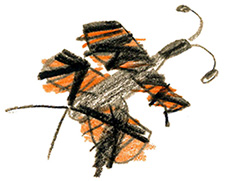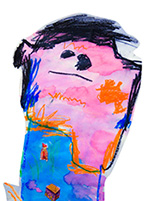Curriculum

Our methodology draws from forward-thinking theories in the fields of education, the arts, and social justice. Our practice is informed by the work of many notable theorists such as Dewey, Bruner, Eisner, Vygotsky, Freire and Gardner. We put these theories into practice through arts-based, emergent curriculum, creating a learning environment that is playful, cooperative, exploratory, integrated and flexible. Our curriculum is guided by a yearly central theme with monthly sub-themes that build throughout the year. Our themes are the common thread that connects our ideas about ourselves and the world we inhabit. It also allows us to take wild rides in our imaginations while still staying tethered to common concepts.Although themes are established, curriculum is not set in stone. We cultivate a culture of Emergent Curriculum. This approach allows us to meet children’s interests that emerge as teachers and children delve into activities and lessons, weaving their shared interests into a fluid, organic exploration of ideas and information.
We have four main curricular areas – Visual Art, Music, Library, and Language. Each day, our moon groups participate in lessons and activities infused with storytelling, artmaking, songs, games, movement, observation, and discussions. We design cooperative and independent projects and activities, with room for both structured and free expression experiences.
“The art room is a place for discovery! We dive into ideas and explore them through the use of multiple media. Drawing, painting, collage, clay play, paper mache, weaving, finger knitting, and cooking are just some examples of how we can unpack and repetitively realize a story, feeling, or thing.”
– Kate Leibrand
Art Specialist
Music
“Music classes at Moonstone are about adventure and expression. Regardless of what sort of songs or concepts I’m trying to teach, I always try to find stories to connect them to. At times we could be taking a narrative from an old opera and play acting it together. Other times we may find ourselves in conflict with magical creatures who we must outwit. Whatever the case, children love connecting to material through storytelling and we work together to form that storyline.
When I’m teaching I also try to look for what lessons can be taught outside of the material we cover. I’ve found that there are always moments to learn about empathy, kindness, perseverance, and other real-world ideas. My favorite part of teaching students at Moonstone is how much of an impact my co-workers and I can have helping students understand these lessons through our artistic outlets.”
– Chris Panico
Music Specialist
Library
“The Library is a magical place. By incorporating books, plays, puppetry, and elements of nature, the library becomes a place of multisensory discovery. Repetition of books throughout the week allows the children to become more interactive with the stories. What influences the direction of the theme is the children. Their curiosities – what they grab on to – pushes the themes to new places.”
– Samantha McConnell
Library Specialist
Language and Culture
“I teach how I learn, with movement, art, song, story telling, silly rhymes, investigation, and asking questions. As a performance artist I am a very physical learner myself and I embrace the young child’s desire for movement and processing things physically. I strive for lessons to be exciting and interesting to the children, while also giving them opportunities to build on predictable patterns and knowledge.”
“I seek to engage a wide variety of intelligences with each Language Arts and Culture Lesson, teaching songs from different cultures and creating rhythms with new words to engage musical intelligence, reading and telling stories to activate linguistic intelligence, discussing sequencing and problem solving to activate logical intelligence, creating images to activate visual intelligence, thematic movement activities to activate bodily intelligence, discussing observations and classifying things in multiple languages to activate naturalist intelligence, working on recognizing feelings of others and creating activities for the children to work cooperatively to activate interpersonal intelligence, and building opportunities for verbalizing introspective thought to activate intrapersonal intelligence.”
“My goal is for children to feel respected, joyful, and curious in my classroom. This means a different thing for each child, and I enjoy trying to figure out what that is.”
– Lane Speidel
Language and Culture Specialist
Sample Day Schedule
8:00 – 9:45
Welcome – Parents drop off (put lunch away, items in cubby, talk to staff if necessary, and say goodbyes); children have a choice of activity.
9:45 – 10:00
Clean Up, Handwashing, & Snack – healthy snacks include fruit, vegetables, soft pretzels, etc…
10:00 – 10:30
All School Music & Morning Play – Entire school gathers in the Common Room to sing songs; teachers and children perform plays based on Moonstone’s favorite stories
10:30 – 12:30
Curriculum
| Art | Music | Library | Language | |
|---|---|---|---|---|
| 10:30 – 11:00 | Blue | Half | New | Full |
| 11:00 – 11:30 | New | Full | Blue | Half |
| 11:30 – 12:00 | Full | Blue | Half | New |
| 12:00 – 12:30 | Half | New | Full | Blue |
12:30 – 1:00
Lunch – New & Blue moons may have lunch at 12pm depending on the group’s needs (everyone finishes by 1:15)
1:00 – 1:30
Nap time – New and Blue Moons begin napping
Structured Play – Blue/Half/Full Moons (all non-nappers)
1:30 – 3:30
Chapter Books/Turtle Time/Park – Half Moons, Full Moons and non-nappers visit the park, weather permitting. Upon return Full Moons listen to chapter books & Half Moons listen to picture books for Turtle Time
3:30 – 3:45
Handwashing & Snack – Healthy snacks provided and occasional birthdays celebrated
4:00 – 5:00
Afternoon Curriculum – Children participate in various activities
5:15 – 5:30
Clean Up
5:30 – 6:00
Afternoon Stories in common room or play room Final pick ups – parents can see the closing assistant director for any information

Ever wonder what a typical day would be like for your child?


